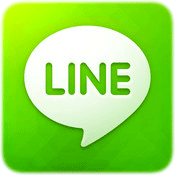Line, an app made by NHN Japan Corporation, which has grown rapidly, amassing over 100 million users since its launch in summer 2011, is typically labelled as a messaging app – and compared to the likes of WhatsApp, Viber and Skype because it offers free calls and texts. But in reality Line’s feature set positions it closer to being a social network. In other words, Line is going after disenchanted Facebookers as much as it’s hoping to woo Skype-calling addicts.
Download Line’s app and you’ll find a matryoshka of other apps and services nestling inside. From games to play with your Line buddies, to utility apps such as Line Camera, which lets you add filters and graphics to photos – à la Instagram. There’s also ‘Official Accounts’ in order to follow verified celebrity Line users to receive their updates; Line Café for forums for chatting to other users by topic; and your own Facebook-esque timeline/wall where you can post updates, photos, videos to let chosen friends know what you’re up to. 
In the U.S., a market which Line entered at the start of this year — having built its initial user base in Asia (it’s especially popular in Japan, with “close to“ 50 million users there) — Line sees an opportunity to take advantage of the space between basic mobile messaging and traditional social networking, says its U.S. CEO Jeanie Han.
More Than Messaging
“I feel that some people are kind of getting tired of being too open on social media,” Han tells TechCrunch. “Although we have several strong competitors in the U.S. we feel that Line serves a need or fills that gap that’s not being fulfilled at the moment.
“Line is more than a messaging app. It’s sort of like social media but it’s not too open. It’s just enough for people to feel comfortable. You get to choose how you want to communicate with your friends and family. You have complete control over that. You don’t have to worry about your picture being taken last night and now the whole world is going to see it,” she adds.
“So it’s more than just text messaging — you can communicate in a fun way — but without ever worrying about your identity being shared or revealed or being sold and not being too open about it. That’s really the selling point of Line. And in the U.S. the timing is great because I do feel that need and that gap has not been fulfilled.”
Han does not specifically name-check Facebook but that’s obviously the social networking elephant in the room – not least because it has its own messaging app, Facebook Messenger, which includes the ability to send free texts/IMs, and also free VoIP calling in the U.S. and Canada (but not currently in all its markets).
There’s no doubt Facebook is the Goliath to Line’s youthful David. But Line’s focus on mobile messaging to generate momentum for a platform/social network (really the opposite of Facebook’s evolution) has proved a successful formula in Asia – and Han says she’s optimistic about the U.S. market, too. “It’s been very well received. Although we don’t have the critical mass in the U.S. just yet, the word is getting out there that Line is really a platform that can make your life more fun, not just a simple messaging app,” she says.
In keeping with this platform approach, Line is available on multiple mobile platforms and also has a web app for use on PCs, Macs and tablets. And its sense of fun is evident in the stickers it offers users as part of the communications mix – some free, others paid in-app downloads (a key revenue stream for the business, although the company isn’t currently breaking out any new revenue figures).
Stuffed With Cartoon Characters
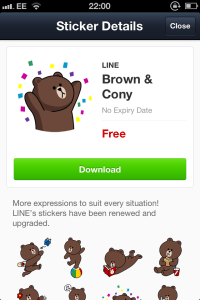 Line hasn’t just recycled the standard yellow-faced emoji/emoticons that are the very definition of a digital cliché. Rather it has created its own set of cutesy cartoon characters to star on stickers and also in the games and apps that live on the Line platform. These characters effectively act as recognisably brand mascots for Line – to the point where it has been able to create spin-off merchandise, such as plush toys and physical stickers in some of its Asian markets (in much the same way that Rovio’s Angry Birds have flocked forth from the small screen to land on toy shop shelves, in books and their own cartoon series).
Line hasn’t just recycled the standard yellow-faced emoji/emoticons that are the very definition of a digital cliché. Rather it has created its own set of cutesy cartoon characters to star on stickers and also in the games and apps that live on the Line platform. These characters effectively act as recognisably brand mascots for Line – to the point where it has been able to create spin-off merchandise, such as plush toys and physical stickers in some of its Asian markets (in much the same way that Rovio’s Angry Birds have flocked forth from the small screen to land on toy shop shelves, in books and their own cartoon series).
The core recurring Line characters, such as Brown the bear, Cony the bunny and Moon, have a cutesy appearance that brings to mind an enduring Asian IP such as Hello Kitty. But Line is not limiting itself to cartoon styles that play best in the Far East – rather it’s localising its sticker content by market and even by user community. It’s also not restricting itself to its own creations but is actively licensing other companies’ IP — so it can offer things like Hello Kitty stickers, too.
Han says Line employs people in each of its markets to specifically follow local trends to help localise sticker content. “We’re customising it to each country and each culture,” she says. “In Spain we’re making specific stickers that are just relevant for the Spanish people, what’s going on in society at the moment, what are the hot topics. We’re going to do the same for the U.S. We already have special [free and paid for] stickers for Snoop Dogg. It’s doing really really well actually. The response has been phenomenal.”
The Lure Of Line’s Stickers
Line is not the only messaging app to offer stickers, of course. Viber has its own purple-haired sticker character Violet, for instance (as well as the usual line-up of yellow-faced emoticons). But despite Viber’s 175 million+ users there’s no sign of spin-off merchandising momentum for Violet plush dolls or games (not yet anyway). While Viber has zeroed in on the free-calls aspect of its messaging app, Line has clearly ploughed in a lot more effort into fleshing out its cartoons and developing fully formed characters that can become IP properties in their own right, not just 2D stickers – a key difference in emphasis.
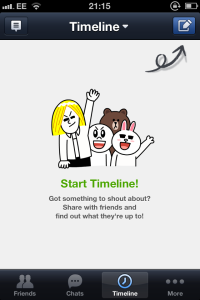 Han, who joined Line after 10 years working in the movie business in Hollywood, is adamant she has joined, first and foremost, an entertainment company – rather than a technology company. “I didn’t go into technology. I went from one entertainment industry to another,” she says. “I know how to bring happiness and how to market entertainment to people and that’s exactly what I’m doing now.
Han, who joined Line after 10 years working in the movie business in Hollywood, is adamant she has joined, first and foremost, an entertainment company – rather than a technology company. “I didn’t go into technology. I went from one entertainment industry to another,” she says. “I know how to bring happiness and how to market entertainment to people and that’s exactly what I’m doing now.
Stickers and cute cartoons obviously play well with young users – and that’s Line’s initial target demographic. In fact 18-to-29-year-old females are its “core target,” says Han, explaining that in Asia, once girls were using Line, boys followed – and then this young “hip” user base helped bring in older users “like a domino effect.”
“People, especially young folks, are really adopting our stickers,” she says. “The ratio of people who are buying things online like our stickers is actually quite high in the U.S., as well as the people who are using our games inside our platform relative to the total number of users, so we’re quite optimistic in terms of our market in the U.S.”
Spain is now Line’s biggest market after Asia – something Han puts down to the cultural appeal of communicating with added visual panache via Line’s stickers since Line did not do much marketing initially. It has now just kicked off a high-profile TV campaign starring Spanish actors Michelle Jenner and Hugo Silva — plus its core sticker characters:
“In Spain it just kind of grew organically,” says Han. “I think it had something to do with the fact that the Spanish people are very passionate, and they’re very expressive and they really loved using our stickers to communicate with each other so it just took off.”
Han is hopeful Line will have strong appeal in Latin America, for similar reasons – so that market is another priority for Line this year, along with the U.S. where she reckons ethnic diversity should also work in its favour. Line intends to create dedicated marketing campaigns for different ethnic communities of U.S. users, she says.
“[Line’s appeal] really depends on the culture, and the kind of communication style of the people. The U.S. works really well because we have a lot of mixtures of cultures. We have a huge Hispanic market that I think will take to our Line app as well, so we’re focused on many different ethnicities in the U.S. Certainly we have enough population in the U.S. to go after each community.”
Tech Plus Pop Culture
Part of its content-localising efforts is likely to involve licensing popular U.S. cartoon characters – to help it to bridge any cultural divide. “Whether they’re Disney characters or Angry Birds or whatever – I think there’s a lot of opportunities for us to co-produce games ourselves with different characters,” she says. “Our characters are very beloved, but if there’s another character from a country or a different company that people love we can put them together into a new game.
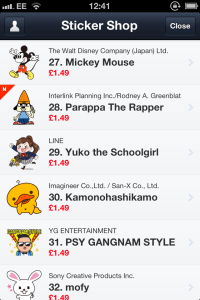 “People at Line are very busy every day talking to these IP owners because there’s a lot of synergy that we can have with our characters combined with some of the other characters… Now that we have over 100 million users, lots of companies actually want to do business with us, they love taking our calls. In the beginning it was a little bit tougher but now the conversation is much easier.”
“People at Line are very busy every day talking to these IP owners because there’s a lot of synergy that we can have with our characters combined with some of the other characters… Now that we have over 100 million users, lots of companies actually want to do business with us, they love taking our calls. In the beginning it was a little bit tougher but now the conversation is much easier.”
While Line’s surface focus is on building out its social entertainment network, this is underpinned by the tech nous of its parent company NHN Naver – a search engine and online gaming company. When it comes to staying ahead of me-too messaging competition, Han argues that Line can win by being faster and quicker as a result of Naver’s long-standing expertise at building digital products.
“Naver is really a technology company so they are very good in terms of product development and they are very fast and nimble, so when it comes to localising for a huge market I think we are probably one of the fastest,” she says. “We have a lot of people and resources dedicated to knowing exactly what each country wants and needs and I would say that differentiates ourselves.”
Han was speaking to TechCrunch from Spain but was due to return to the U.S. soon to ramp up the company’s marketing and promotion efforts here – to continue growing the Line user-base from its current standing of “way above” 100 million users globally. Line’s U.S. marketing efforts have initially been relatively minimal, says Han – with “grass routes marketing” and some official accounts using celebrities such as Snoop Dogg rather than a full “360 degree campaign.” But that’s going to change.
“The demographic is so large in America that I think we’re going to pick some of the metropolitan areas, New York and L.A. and some of the bigger cities and really go after our young demographic,” she says. “As soon as I get back to the States we are going to engage a big agency to help us out in terms of doing more – not just below the line but also some above-the-line marketing campaigns – including radio and more online and more mobile and we’ll do more events.
“We’ve been watching how the market is evolving because we have a lot of competition in the U.S., more so than other countries, so we were just kind of seeing what the right timing would be to really start ourselves so you can expect to see a lot more of Line — not only in the press but also probably in terms of our celebrities that we’ll be using and more marketing efforts in the coming months.”
Staying Freemium
Han says Line doesn’t have any plans to start charging for its app – referencing some of the rumours around rival WhatsApp adding subscription fees (it does already charge for its iOS app) and saying the rumours have helped Line grab more attention in markets like Spain. Its freemium approach of selling stickers in app, and offering official accounts to celebrities and brands, seems to be working just fine for Line.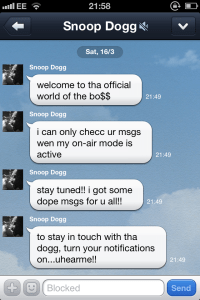 “[Sticker revenue is] growing very nicely but we’re not disclosing any numbers for our revenue just yet,” she says. “But we are making revenue and every month it’s growing quite nicely.”
“[Sticker revenue is] growing very nicely but we’re not disclosing any numbers for our revenue just yet,” she says. “But we are making revenue and every month it’s growing quite nicely.”
Line’s B2C co-marketing platform – via its official accounts feature — is also a key part of its monetization strategy, giving brands and celebrities their own marketing channel to talk to and sell directly to Line users who have opted in to receive their messages. This channel lets brands reach fans directly, with the ability to push out promotions, coupons and disseminate their news.
“We’re creating a completely different B2C marketing platform. I don’t think this has really been done in the past. Unlike your traditional marketing channel like TV or online you can directly go after your consumers at once, so this has been a very effective platform for us,” says Han, adding: “I don’t have enough time right now in Spain to have a meeting with all these companies that are asking to be a part of our official accounts.”
Could Line be spun out from Naver? It’s certainly “a possibility,” according to Han who notes that it fits with Line’s plans to open an office in each of the territories it’s successful in. “It’s certainly something that we’re considering,” she says. “It’s nothing official at the moment but like any company that’s doing well, there’s no reason why not to spin off — so it’s absolutely something we’re contemplating.”
